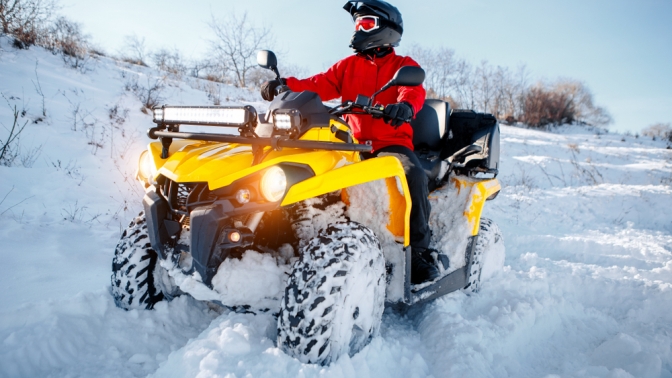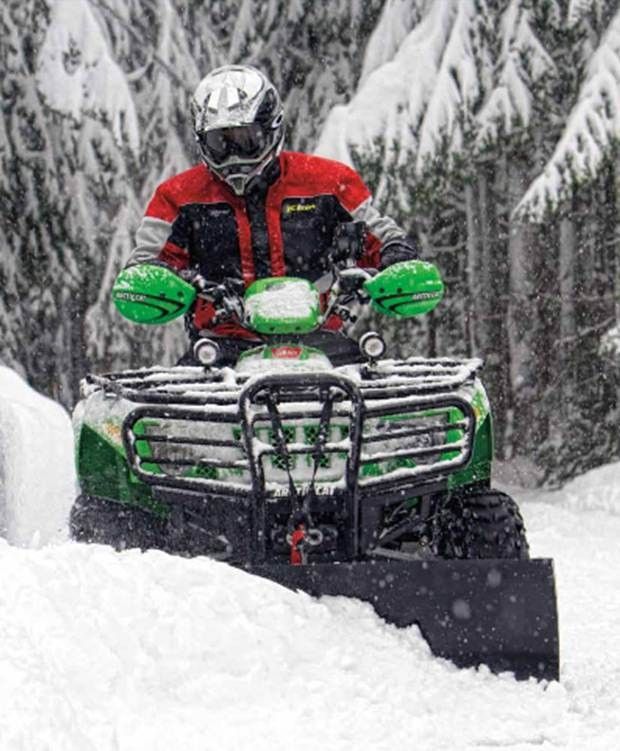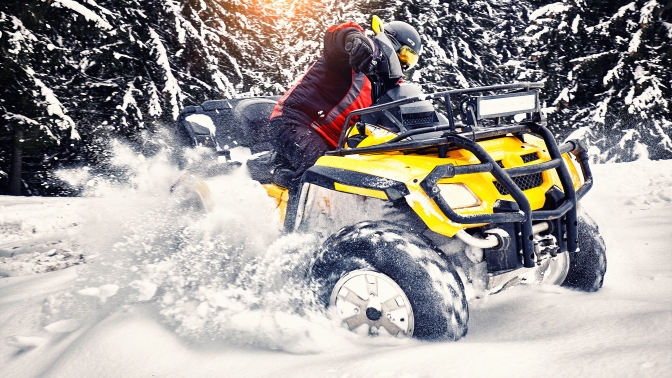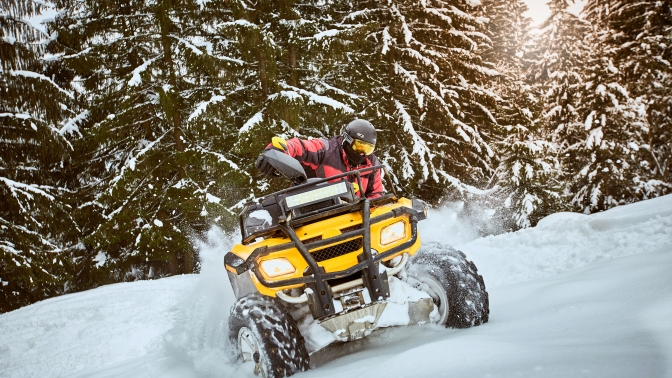atv storage tips atv tips atv winter storage tips storage an atv storing a utv utv storage tips utv tips utv winter storage tips
All-terrain vehicles and utility-terrain vehicles are built to be tough, but bone-chilling temperatures can still have an effect if you haven’t fully prepared your vehicle for the winter cold. Read on to find out how to ensure your ATV or UTV is fully ready to weather the winter.
1. Drain the fuel and add a stabilizer
If you have a gas plastic tank, drain all of the fuel out of your ATV or UTV, including the tank, fuel lines and carburetor. If you have a metal tank, fill the tank up full and add a stabilizer. Metal tends to rust in humid areas, and the stabilizer will mitigate moisture in the gas tank. This helps you avoid the negative side effects of water freezing then thawing inside your gas tank.
2. Inflate the tires
No tire maintains perfect pressure over many months even at rest, so having your tires fully inflated before the winter begins will ensure that they are still in an acceptable range by winter’s end. You’ll still need to reinflate to full pressure before riding the vehicle again, but you’ll at least reduce risks of damaging the tires if they become fully flat.
3. Clean the vehicle
No one wants to get into their vehicle after a long winter and find that dirt and debris have been there all this time. Thoroughly cleaning the interior and exterior of the vehicle ensures that build-up does not occur and keeps your vehicle ready to go at the first sign of spring.
4. Change the oil and the air filter
The air filter and oil are often quite spent by Autumn after long days of use in the particulate-filled air of summer. Plan to change them both before the weather turns chilly.
5. Cover the vehicle
Choose breathable fabrics that allow moisture to escape if any gets inside so that your vehicle is not susceptible to rust.
6. Consider a trickle charger to save battery life
Trickle chargers keep your battery from quickly losing charge and going dead on those cold days, and are worth the investment if you are in an area that gets sustained intense cold.
7. Choose a good storage location
Finding a dry location like a garage or shed will keep your ATV or UTV protected from much of the harsh effects of snow and cold. It is even better, according to MotoSport , if you can avoid sunlight that might reach plastic components or land on the tires themselves. Additionally, use blocks or a lift to keep the ATV or UTV off the ground to protect the tires and suspension.
With these tips, your ATV/UTV will be safely stored for the winter months. Need to move your ATV/UTV to a good winter storage location? Find the ideal long loading ramps to help transport your vehicle to storage and easily bring it back for spring and summer adventures!
For many ATV and UTV owners, getting their machine ready for winter is essential to keep your ATV or UTV in good shape and prolong its life, but it is also likely something that has just become part of your routine without much thought.
By taking the extra time to properly store your ATV or UTV while not in use, you can better preserve and maintain your machine and ensure it works better when it comes time to remove it from storage.
How do you Store An ATV or UTV For Winter?
While it may seem like a lot of work just to store your ATV or UTV, you can make sure that you are protecting your investment. Taking the time to keep the maintenance up will ensure that you won’t be having to purchase a new ATV or performing costly repairs once spring rolls around. Each of these steps is discussed in more detail below.
When it comes to winterizing your ATV, there are some pretty important things you can do to prepare your vehicle for storage. These five tips are the best things you can do to make sure your ATV or UTV in top condition when you bring it out of storage.
These five tips are the best things you can do to make sure your ATV or UTV in top condition when you bring it out of storage.
The first step to storing your ATV for the winter is to make sure that you clean your ATV as much as possible. Leaving any sort of dirt, water, or other residue on your quad can lead to it eating away at the paint or body of your ATV while in storage.
Taking the extra time to make sure you get every area clean will leave you with no surprises once it is time to pull it back out.
You should be cleaning your ATV after each use to minimize erosion and damage. By taking off the dirt, grease, and debris that can end up on your vehicle, you are protecting the body and the paint of the vehicle.
Cleaning your ATV also includes cleaning and lubricating any parts that may get dirty. Not only is this a great way to extend your ATV life, but you may even come out with more knowledge about how your machine works, and it may lead to you spotting potential issues you can take care of before they become major problems.
After you have cleaned your ATV, you will want to refresh any liquids that your vehicle uses. This includes your oil and even the gas tank.
Changing your fluids may seem like it is not 100% necessary, but trust me, it is! Cold weather tends to thicken up the liquids in an ATV, which can damage the engine if the liquids are dirty. Dirty oil contains debris and acids that can even cause certain parts of your engine to erode. If your oil filter is dirty, you may also want to change that before storing your ATV as well.
Even though you are about to store your ATV, make sure that you fill-up the gas tank too. This helps to prevent any condensation from forming in your tank or your fuel lines. Any presence of water in your fuel line can freeze and cause your ATV not to start.
The best option is to use a fuel stabilizer before storage. Pour it into your tank and leave your ATV running for around 10 minutes to make sure it is distributed.
When it comes to your battery, the cold weather can be its’ number one enemy. Batteries are not cheap, and cold weather will drain your battery before you know it.
If you have a standard battery, the best option is to remove the battery and store it in a warm area. You can also purchase a smart charger or a trickle charger which can help it last during colder months.
3. Check Your TiresSince storage can be rough on tires, you will want to check out your tires and make sure they are inflated to the proper pressure. This will make sure that you do not have to deal with a flat tire right once you pull it out of storage.
If you have any questions about how to test check and fix your tire pressure, we have a guide for that.
Extended periods of rest are never great for a set of tires. Before you put your ATV away for the winter, you should make sure that you inflate the tires to the proper pressure.
This prevents potential rotting from freestanding water where you are storing it, and there will be a reduced chance of flat spots over the length of storage.
Although the pressure is not going to remain perfect, you should not have to fill them up once you bring your ATV out of storage too much. You could also place your ATV on a stand, which is the preferred method if you want to protect your tires to the fullest extent.
4. Seal any Open AreasDuring storage, your ATV could become home to some little animals. Make sure you take up the time to block any pipes or open areas on your ATV. It is not uncommon for a cold squirrel to crawl in your ATV and chew up spark plugs. You can use tape, fabric, or whatever you have on hand to secure your ATV.
It would be best if you also took the time to cover all open areas such as an exhaust pipe or areas where an animal or insect could crawl into your ATV.
5. Buy a High-Quality CoverThe final step is to make sure that you are using a high-quality cover to protect your ATV or UTV from any sort of weather-related issue. If you are storing your quad in an indoor facility, make sure the conditions are sufficient to protect your ATV.
Especially if you are storing your ATV outside, you should be investing in a high-quality cover that can help prevent the elements from having a negative impact on your ATV.
This should be a waterproof cover that you can secure to the ground or your ATV to keep it safe from snow, rain, or ice. A cover can also help prevent animals from finding a new home for the winter as well.
Even if you are storing your ATV inside, you should still consider using some sort of cover that is waterproof. This will help deal with any humidity in the air and keep dust, debris or animals from getting inside.
The cover should always cover all areas of your ATV to keep it safe from potential condensation, debris, or animals. As mentioned earlier, if you are storing your vehicle inside, using a stand to store your ATV is an excellent option for those who are looking to protect their ATV as efficiently as possible.
In some areas of the country, it is difficult to drive ATVs during the winter months, so owners decide to store their vehicles during the off-season.
Long term storage of your ATV is more than just leaving it in a garage or shed. Since you will no longer be driving and the cold season is approaching, you need to prepare your transport for hibernation. It won't take long, but preparation will keep you protected from corrosion and damage, and when the winter is over, you'll be ready to go. nine0003
Preparing your ATV for long-term storage requires little more than a simple post-ride cleaning. Yes, cleaning is absolutely necessary, but there are a few more things, obvious and not so obvious, that many owners overlook or forget. The tips below will help you keep your vehicle in tip-top condition, ready for the road as soon as winter is over.
As already mentioned, wash your ATV completely. Apply lather, rinse off and apply lubricant (on the drive chain and all other parts that need to be lubricated), then apply protectant on the plastic parts - all the things you usually do when preparing for a ride. The only difference is to apply WD-40 to the exhaust pipe to prevent corrosion, and plug the hole in it to keep dust or insects out. Plug the hole with a rag or, better, use a special plug. In addition, it does not hurt to coat all unpainted and polished metal parts with WD-40. nine0003
The only difference is to apply WD-40 to the exhaust pipe to prevent corrosion, and plug the hole in it to keep dust or insects out. Plug the hole with a rag or, better, use a special plug. In addition, it does not hurt to coat all unpainted and polished metal parts with WD-40. nine0003
Gasoline will degrade if left for too long. If your ATV has a plastic fuel tank, it's best to drain all the fuel - not only from the tank, but also from the hoses and carburetor. On machines with a metal tank, depending on where you live, you need to do the opposite. In an empty tank, rust can begin to form in places where condensate accumulates - so it is better to fill the tank and add a stabilizer. Be sure to start the engine and let it idle so that the stabilized fuel fills the entire system. nine0003
Take care of the battery. An unused battery drains quite quickly, and if left in this state, the battery life will be greatly reduced. The most convenient way is to connect a charger to the battery, which will use very little electricity, but keep the battery charged all winter. In the spring, do not forget to turn it off. Most chargers use float or technology mode when the battery is fully charged. Most likely, you already have such a device, but if you are a beginner or have recently moved from a region where you could ride an ATV around the clock, get it. nine0003
The most convenient way is to connect a charger to the battery, which will use very little electricity, but keep the battery charged all winter. In the spring, do not forget to turn it off. Most chargers use float or technology mode when the battery is fully charged. Most likely, you already have such a device, but if you are a beginner or have recently moved from a region where you could ride an ATV around the clock, get it. nine0003
Tires deflate slowly over time, so inflate them to the maximum before storing. It's also best to check them once a week. Also, tires should not be left on frozen concrete for the next six months. Use the blocks to lift the quad off the ground so you take the load off the suspension.
Change oil and filter. Old oil contains dirt and chips, and over time it can thicken and remain in the crankcase or on engine parts. After changing the oil and filter, let the engine run for a few minutes to coat all moving parts with fresh oil. Then crank the engine a couple of times every month without starting to keep the moving parts lubricated. nine0003
Then crank the engine a couple of times every month without starting to keep the moving parts lubricated. nine0003
In addition, remove the air filter, as rodents like to make a den or store their supplies in it, and it can dry out during the winter. Don't forget to replace the filter cover.
Cover your ATV, but don't use plastic. You need to cover with breathable material, otherwise the moisture will not evaporate and rust and mold will begin to form.
In general, it is best to store your ATV in a dry place that is not too cold. If your garage or shed has windows, make sure that sunlight will not hit the plastic parts and tires. Follow these tips and when the new season starts, you'll be ready. nine0003
Cold and snow are the harbingers of the end of the motorcycle season. And at this time, the rider needs to take care of the conservation of the ATV for the winter. But many ATV owners ignore this procedure or think that standard maintenance is enough. Therefore, let's figure out how to store an ATV in winter, and why improper preservation of equipment is dangerous.
But many ATV owners ignore this procedure or think that standard maintenance is enough. Therefore, let's figure out how to store an ATV in winter, and why improper preservation of equipment is dangerous.
It is worth noting right away that you can use the ATV even in winter. And this is not surprising, because powerful equipment makes its way along snow-covered routes without any problems and can help in the household (with snow removal). Although the operation of an ATV in winter is slightly different from the usual use of the device.
To use the quad at low temperatures you need:
 nine0052
nine0052 To make riding an ATV comfortable in winter, the rider is recommended to buy special equipment and equip the equipment with heated handles.
ATV conservation - a whole range of procedures that allow you to keep your equipment working. Ignoring them can lead to:
Ignoring them can lead to:
If you don't plan on riding your quad bike in the winter, then it's a must to prepare your vehicle for downtime. nine0003
So, we found out if it is possible to ride an ATV in winter. Now you need to decide where to store the device during this period. And the best place for any motorcycle is a warm, dry room. Ideally, the garage should be heated and well ventilated.
After preparing the room, you should:
 It is also not recommended to use too aggressive chemicals or hard brushes. nine0052
It is also not recommended to use too aggressive chemicals or hard brushes. nine0052 It's also important to change all your fluids, even if you don't plan to ride your ATV in the winter. We are talking about antifreeze and engine oil.
Another stage of equipment conservation is fuel system cleaning. First, drain the old gasoline, and then start the quad. So you can dry the system and use the remaining drops of fuel. After that, close the fuel cock and pour 2-2.5 liters of gasoline into the tank. nine0003
So you can dry the system and use the remaining drops of fuel. After that, close the fuel cock and pour 2-2.5 liters of gasoline into the tank. nine0003
When figuring out how to store your ATV in the winter, you should definitely think about the battery. This is one of the most vulnerable elements of technology that will not survive severe frosts. Therefore, it must be preserved separately.
It should be said right away that when preparing an all-terrain vehicle for winter, it is imperative to remove the battery. It is recommended to store the battery separately, in a pantry at home or in another heated room.
Winterizing the battery starts with dismantling and cleaning it. The battery must be free of dirt, grease or corrosion. After that you need:
Important: Over time, the battery will lose its charge, so it will need to be recharged periodically (2-3 times during the winter).
Many riders are puzzled about how to store the ATV in the winter if there is no garage or the chosen room is very damp. In this case, the owner of the equipment will come to the aid of a special cape. Such an awning will protect equipment from moisture, rain, hail, snow, sun and dirt. nine0003
But when buying a cover, it is important to consider:
